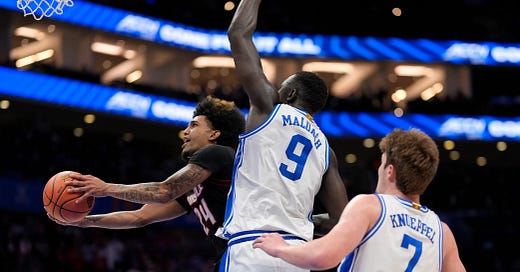For all the data points drawn at last week’s NBA Draft Combine, plus the video reviews, interviews, and individual workouts to come, the selection process remains, for all but the rare “sure things”, a projection. Educated guesses by those allegedly trained in the art.
Some professional GMs, especially those selecting after Dallas tabs Duke’s Cooper Flagg at No. 1, will inevitably get it wrong at the 2025 Draft that is still 37 days away. Like they do every year. And it’s not always solely the GM’s fault when it happens, as unforeseen injuries, coaching, and the player’s own developmental shortcomings can get in the way. Understand that all but a couple of the consensus top 15 picks are still teenagers.
Which is why I’m curious about how a GM, particularly one like Brooklyn’s Sean Marks who owns a mid-lottery pick, approaches the process. At No. 8 overall, Marks will have to do deep dives into a pool of flawed players and determine the best fit for the club’s rebuild.
The Nets haven’t made a pick in the lottery since taking Derrick Favors at No. 3 overall in 2010. And Brooklyn only has this one because Marks traded the equivalent of four 1s (2025 was a swap with Phoenix) a year ago to regain the team’s 2025 and 2026 picks back from Houston.
That makes the June 25 choice kind of a big deal.
With that in mind, how big a swing will Marks take on a player he might project can achieve star NBA status but is at a higher risk of busting? Would it be more prudent to take a player with a higher floor but a lower ceiling? It’s not so simple, especially when you’re evaluating clips from the generally horrendous product known as U.S. college basketball.
ACC ball was particularly odious last season, which I bring up because two of the players who could conceivably be on the board at No. 8 are Duke’s Khaman Maluach and Kon Knueppel (Note: Some so-called experts, like those at The Ringer, predict both will be gone by the time the Nets are on the clock. No one knows.)
The dichotomy between the more NBA ready Knueppel and the tantalizing prospect Maluach is exactly the dilemma I mentioned above. The 7-foot 1 (without shoes) Maluach oozes upside. He’d seemingly fit in line with Marks’ drafting history following Brooklyn’s past selections of Jarrett Allen, Nic Claxton, and Day’Ron Sharpe, all traditional lobs-and-blocks bigs. Maluach, who played in the Olympics and the NCAA Final Four before he turns 19 in September, is considered to have a superior shooting touch--he shot 76.6% from the line in college, as opposed to Allen’s 56.4%, Claxton’s 61%, and Sharpe’s 50.5%--and thus should theoretically have a better chance at actually extending his range as a pro to the three-point line.
Again, that will depend on Maluach’s development. That also applies to building up his body, which got pounded in that semifinal loss to Houston where he grabbed zero rebounds in 21 minutes despite a six-inch height advantage. Marks may have a good track record when it comes to picking centers, but there is a long line, including top 3 picks like James Wiseman, Greg Oden, and Hasheem Thabeet, of others who didn’t come close to panning out as hoped.
However, it’s unlikely Knueppel matches Maluach’s impact if both end up living up to their potentials given their size/athleticism discrepancies. That doesn’t mean Knueppel is deserving of the slander thrown his way from some in Nets Nation. To state he’ll be nothing more than Joe Harris 2.0—and therefore undeserving of a premium pick--is a lazy take. Though similarly sized and with nearly identical three-point percentages in college (Knueppel boasted a tick higher in both metrics), Knueppel is a far superior ballhandler/playmaker who has displayed some of the high-level footwork to finish inside (62.1% at the rim last season per CBB Analytics) that you see from Knicks star Jalen Brunson. By the way, Harris was one of the NBA’s best three-point marksmen for about a six-year period, which isn’t something to casually dismiss as the league has since moved further into a three-point dependency.
Obviously, Knueppel’s ability to defend at the NBA level with a 6-foot 6 wingspan and substandard lateral speed is a concern. He was able to get away with those limitations in college not just because the competition stunk; he’s a tough, physical competitor, even on possessions where he was forced to switch onto bigger players. That’s translatable to the pros.
Overall, I would put Knueppel’s comp in a range from Corey Kispert at worst to Desmond Bane at best. Role player to a complementary starter on a contending team. Would that be acceptable to Nets fans who were under the delusions that tanking would yield a transformational player?
Meanwhile, Maluach is more of a blank slate. If he hits the gym, if he develops a three-point stroke, if he takes to defensive coaching, he could be an All-Star. But that’s a lot of “ifs.”
Marks will have to sort through all kinds of “ifs” as he puts together his 2025 Draft board. Other than Flagg and Knueppel, the only consensus top-10 pick to shoot at least 35% from deep last season was Texas wing Tre Johnson. It’s easy to say of a prospect, “Oh, he’ll pick up the three-point knack over time.” It’s not so easy in practice.
With such an important pick, the Nets’ risk/reward analysis will be interesting.




Another good take. Others in the Net’s range have the same safer floor, high ceiling conundrum. I like Maluach more than Knueppel. Maluach gives me a Mutumbo vibe. Maluach is 18. That said, we really need a PG. Fears has the most upside but he likely will be gone at eight. Jackucionis has better size and shooting but less athleticism and needs to improve his handle. My guess is it will come down to Maluach, Jacko, Queen, or Knuneppel at eight.